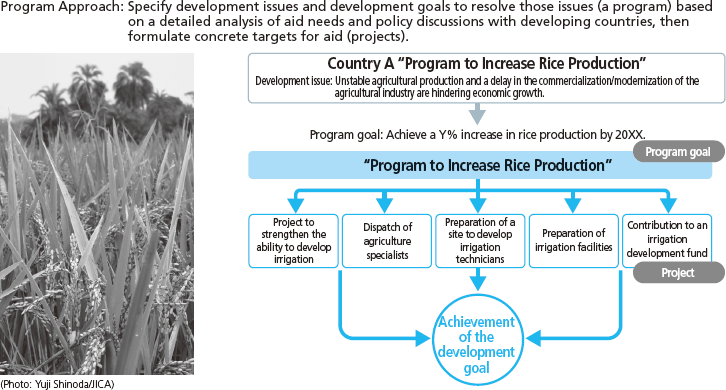Japan's Official Development Assistance White Paper 2011
Chapter 3 The Orientation of New Aid

A Japanese expert and Bolivian technicians read weather measurement data on a computer at an observation point outside La Paz as part of the "Study on Impact of Glacier Retreat on Water Resource Availability for cities of La Paz and El Alto" in Bolivia (Photo: Shinichi Kuno/JICA)
Section 1 Strengthening the Program Approach
To achieve the maximum effect with a limited budget, while gaining a broad understanding of Japanese people in the midst of Japan's economic and financial crisis, it is necessary to implement strategic and effective aid through "selection and concentration." To accomplish this, a policy of strengthening the program approach (an approach that combines various aid methods for specific development issues that span multiple projects) was stipulated in "ODA Review Final Report" (issued June 2010) as well.
In the past, in principle, the implementation of individual aid projects was considered in accordance with requests from developing countries for individual projects, so there was inevitably a tendency to focus on individual projects when judging the necessity and results of aid. In the future, Japan will proceed with transition to a program approach, in which goals for the resolution of specific development issues will be established based on policy discussions with developing countries, then the concrete projects required to achieve those targets will be formulated.
Using this method to combine grant aid, loan aid, technical cooperation, and a variety of other methods of assistance organically for individual projects that are required to achieve the goals of the program can be expected to increase the synergistic effect between projects and bear greater results throughout the whole. In addition, it will become possible to a certain degree to forecast the scale and elements that must be invested for the achievement of the program goals, making it easier for the governments of partner countries and other donors to formulate medium and long-term development and aid strategy. Further, it will be possible to give a more rational and consistent explanation of Japan’s policy intentions for the aid and the impact of the aid, etc., leading the fulfillment of the government’s accountability.
The following test programs have already been selected for implementation of the program approach on a trial basis.
[Test programs]
(1) Indonesia "Jakarta Metropolitan Transportation Program"
The capacity and capability for transportation and traffic has reached the saturation point in the Jakarta metropolitan area. This program aims to improve the investment and business environments in the area by improving and streamlining the transportation, traffic, and distribution infrastructure.
(2) Ghana “Program on Enhancement of Maternal and Child Healthcare System in the Upper West Region”
This program aims to improve the maternal and child healthcare system (a mechanism for systematic provision of preventive and treatment services related to maternal and child health) in the Upper West Region that Japan has been implementing aid as a priority.
(3) Tanzania "Program to Strengthen Rice Production Capacity"
Japan is also acting as a major aid-giving country to coordinate aid in Tanzania. This program focuses particularly on the agricultural sector, which is suffering from unstable production capacity, and aims to increase rice production capacity.
(4) Bangladesh "Basic Education Improvement Program"
Although the enrollment ratio has improved, a low rate of completion (high dropout rates and repetition rates) is a problem in Bangladesh. This program aims to improve the completion rate in basic education by improving the quality of education.
(5) Laos "Program for Power Development"
Although the potential for water-power development is high, Laos suffers from an insufficient ability to supply power domestically and a low ratio of electrification. This program aims to expand the safe and stable electrical power supply.

A traffic jam during the evening rush hour in Indonesia's capital Jakarta. Improvement of the public transportation infrastructure is required. (Photo: Shinichi Kuno/JICA)
Program Approach (image)

